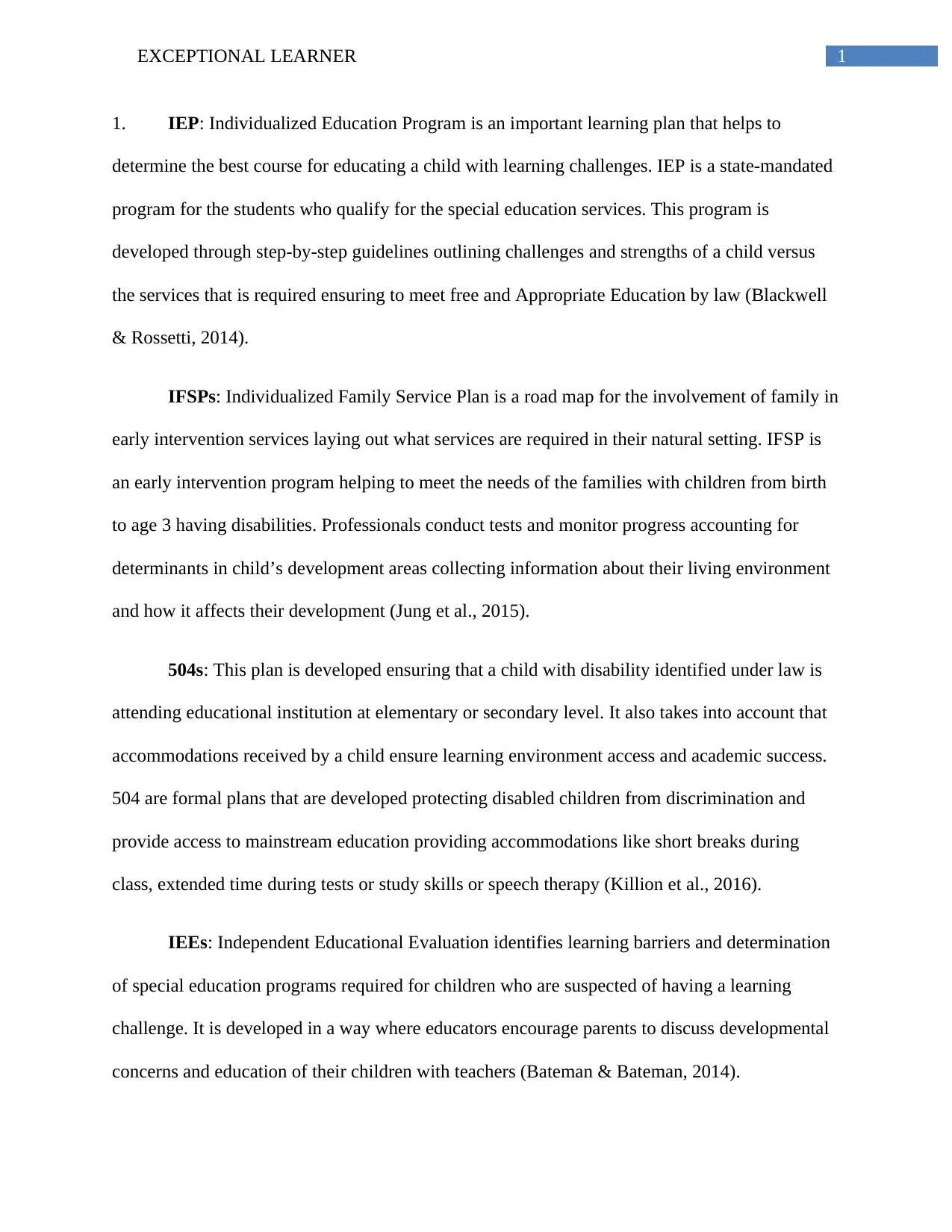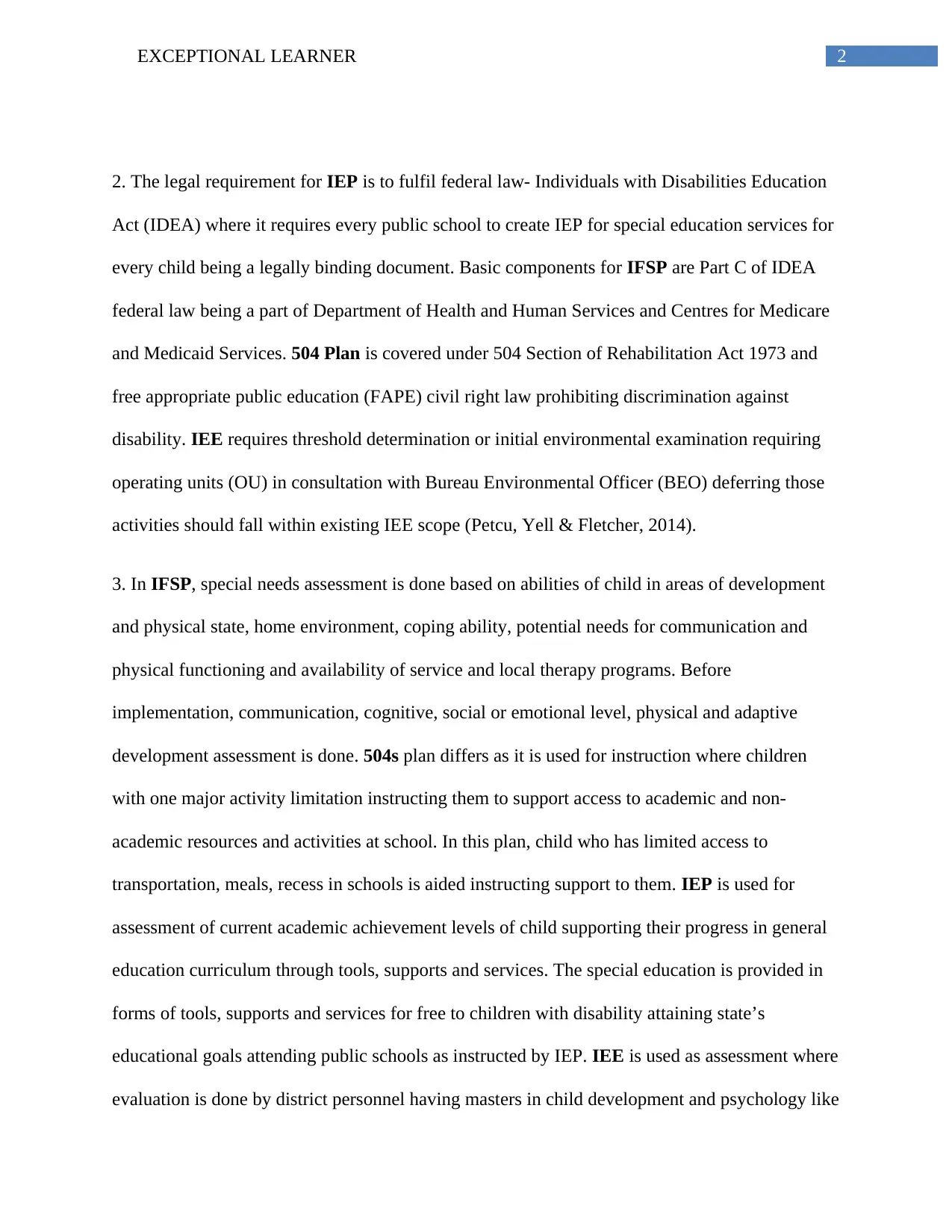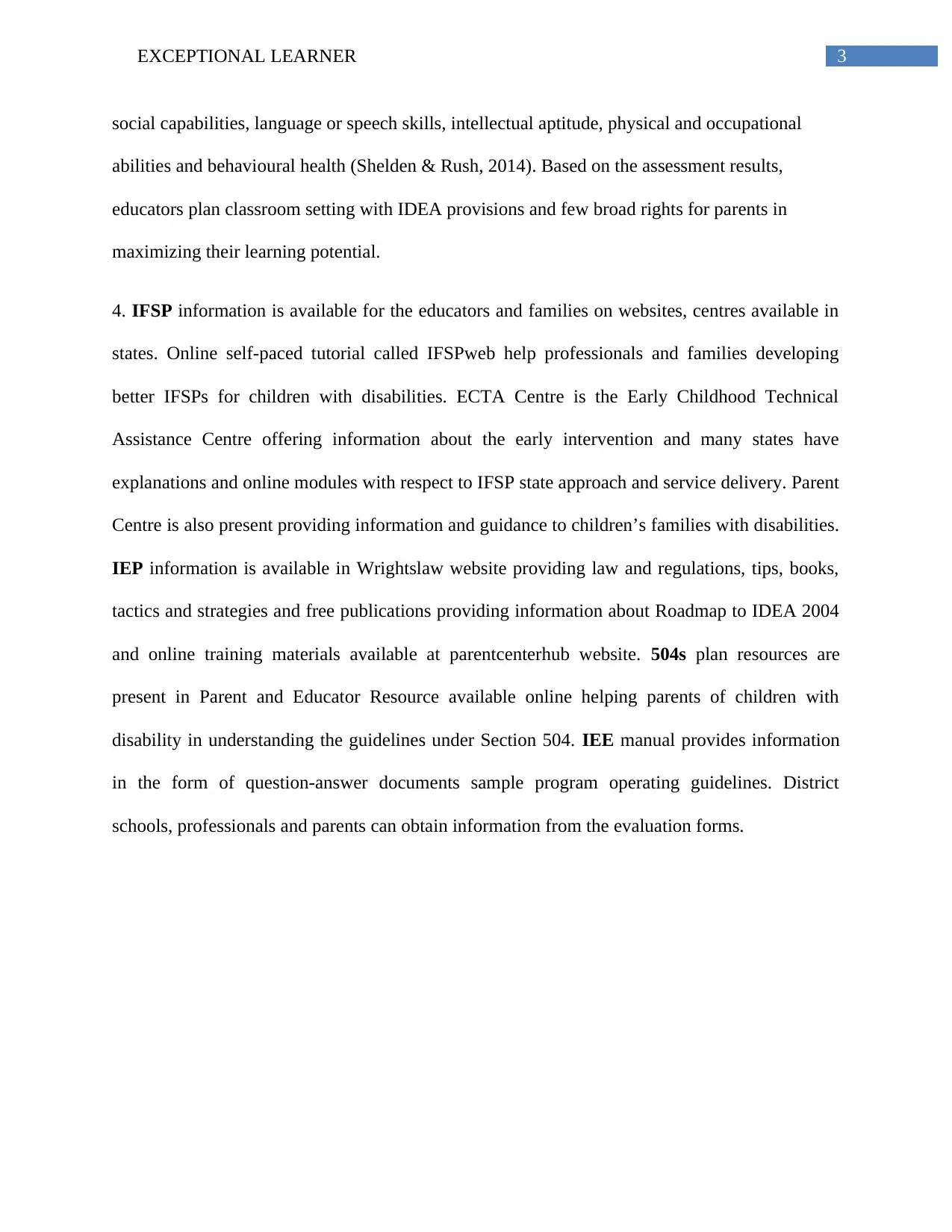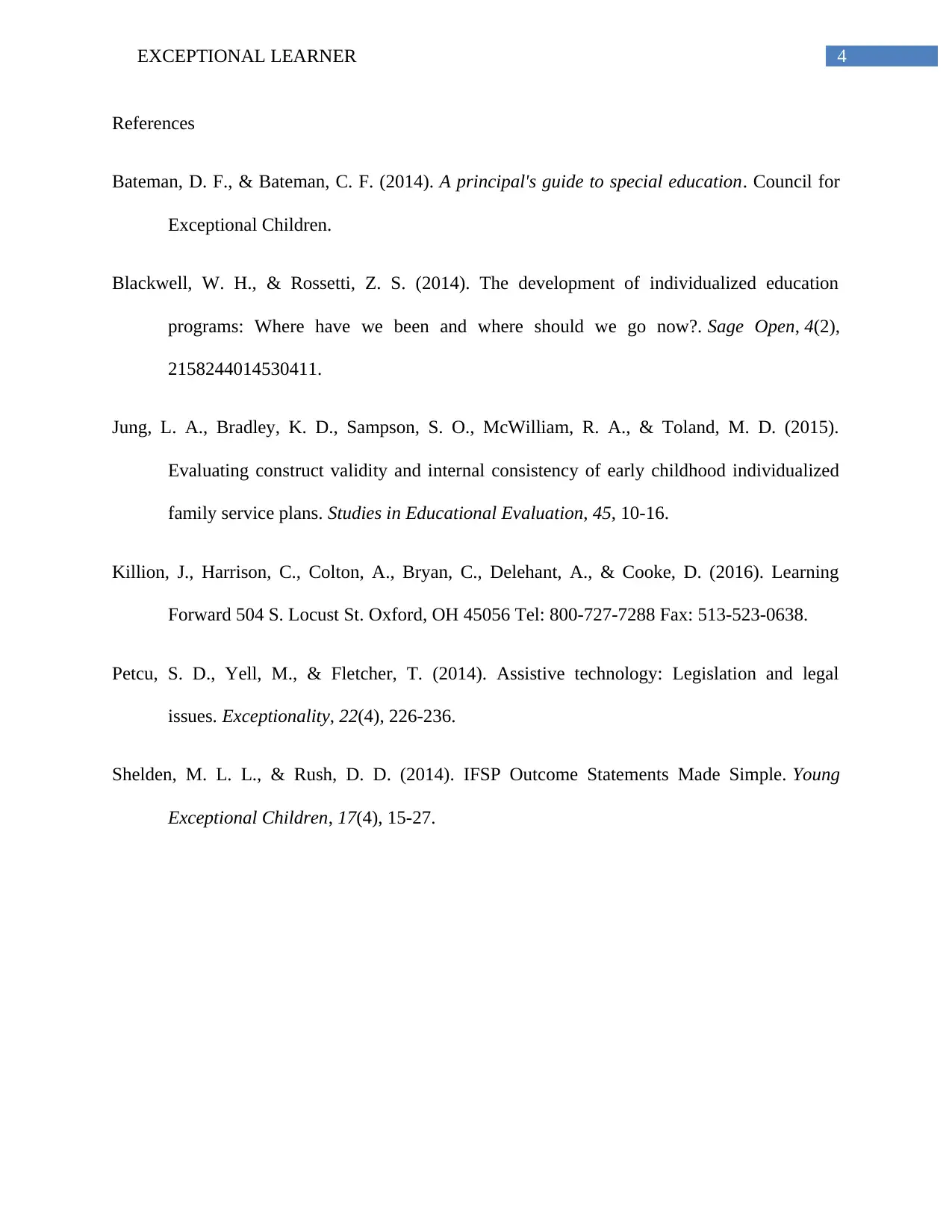Exceptional Learner Assignment: Understanding IEP, IFSP, 504, IEE
VerifiedAdded on 2020/05/28
|5
|1135
|256
Homework Assignment
AI Summary
This assignment provides a detailed overview of Individualized Education Programs (IEP), Individualized Family Service Plans (IFSP), 504 plans, and Independent Educational Evaluations (IEE) for exceptional learners. It explains the purpose of each plan, the legal requirements, and the assessment processes involved. The document highlights the key components of each plan, including the assessment of a child's abilities, home environment, and potential needs. It also details the resources available to educators, families, and professionals for developing and implementing these plans. The assignment covers topics such as special needs assessments, legal frameworks like IDEA and Section 504, and the role of assessments in planning classroom settings. It provides valuable insights into supporting children with disabilities and maximizing their learning potential. The assignment also includes a list of references to support the information provided.

Running head: EXCEPTIONAL LEARNER
Exceptional learner
Name of the Student
Name of the University
Author note
Exceptional learner
Name of the Student
Name of the University
Author note
Paraphrase This Document
Need a fresh take? Get an instant paraphrase of this document with our AI Paraphraser

1EXCEPTIONAL LEARNER
1. IEP: Individualized Education Program is an important learning plan that helps to
determine the best course for educating a child with learning challenges. IEP is a state-mandated
program for the students who qualify for the special education services. This program is
developed through step-by-step guidelines outlining challenges and strengths of a child versus
the services that is required ensuring to meet free and Appropriate Education by law (Blackwell
& Rossetti, 2014).
IFSPs: Individualized Family Service Plan is a road map for the involvement of family in
early intervention services laying out what services are required in their natural setting. IFSP is
an early intervention program helping to meet the needs of the families with children from birth
to age 3 having disabilities. Professionals conduct tests and monitor progress accounting for
determinants in child’s development areas collecting information about their living environment
and how it affects their development (Jung et al., 2015).
504s: This plan is developed ensuring that a child with disability identified under law is
attending educational institution at elementary or secondary level. It also takes into account that
accommodations received by a child ensure learning environment access and academic success.
504 are formal plans that are developed protecting disabled children from discrimination and
provide access to mainstream education providing accommodations like short breaks during
class, extended time during tests or study skills or speech therapy (Killion et al., 2016).
IEEs: Independent Educational Evaluation identifies learning barriers and determination
of special education programs required for children who are suspected of having a learning
challenge. It is developed in a way where educators encourage parents to discuss developmental
concerns and education of their children with teachers (Bateman & Bateman, 2014).
1. IEP: Individualized Education Program is an important learning plan that helps to
determine the best course for educating a child with learning challenges. IEP is a state-mandated
program for the students who qualify for the special education services. This program is
developed through step-by-step guidelines outlining challenges and strengths of a child versus
the services that is required ensuring to meet free and Appropriate Education by law (Blackwell
& Rossetti, 2014).
IFSPs: Individualized Family Service Plan is a road map for the involvement of family in
early intervention services laying out what services are required in their natural setting. IFSP is
an early intervention program helping to meet the needs of the families with children from birth
to age 3 having disabilities. Professionals conduct tests and monitor progress accounting for
determinants in child’s development areas collecting information about their living environment
and how it affects their development (Jung et al., 2015).
504s: This plan is developed ensuring that a child with disability identified under law is
attending educational institution at elementary or secondary level. It also takes into account that
accommodations received by a child ensure learning environment access and academic success.
504 are formal plans that are developed protecting disabled children from discrimination and
provide access to mainstream education providing accommodations like short breaks during
class, extended time during tests or study skills or speech therapy (Killion et al., 2016).
IEEs: Independent Educational Evaluation identifies learning barriers and determination
of special education programs required for children who are suspected of having a learning
challenge. It is developed in a way where educators encourage parents to discuss developmental
concerns and education of their children with teachers (Bateman & Bateman, 2014).

2EXCEPTIONAL LEARNER
2. The legal requirement for IEP is to fulfil federal law- Individuals with Disabilities Education
Act (IDEA) where it requires every public school to create IEP for special education services for
every child being a legally binding document. Basic components for IFSP are Part C of IDEA
federal law being a part of Department of Health and Human Services and Centres for Medicare
and Medicaid Services. 504 Plan is covered under 504 Section of Rehabilitation Act 1973 and
free appropriate public education (FAPE) civil right law prohibiting discrimination against
disability. IEE requires threshold determination or initial environmental examination requiring
operating units (OU) in consultation with Bureau Environmental Officer (BEO) deferring those
activities should fall within existing IEE scope (Petcu, Yell & Fletcher, 2014).
3. In IFSP, special needs assessment is done based on abilities of child in areas of development
and physical state, home environment, coping ability, potential needs for communication and
physical functioning and availability of service and local therapy programs. Before
implementation, communication, cognitive, social or emotional level, physical and adaptive
development assessment is done. 504s plan differs as it is used for instruction where children
with one major activity limitation instructing them to support access to academic and non-
academic resources and activities at school. In this plan, child who has limited access to
transportation, meals, recess in schools is aided instructing support to them. IEP is used for
assessment of current academic achievement levels of child supporting their progress in general
education curriculum through tools, supports and services. The special education is provided in
forms of tools, supports and services for free to children with disability attaining state’s
educational goals attending public schools as instructed by IEP. IEE is used as assessment where
evaluation is done by district personnel having masters in child development and psychology like
2. The legal requirement for IEP is to fulfil federal law- Individuals with Disabilities Education
Act (IDEA) where it requires every public school to create IEP for special education services for
every child being a legally binding document. Basic components for IFSP are Part C of IDEA
federal law being a part of Department of Health and Human Services and Centres for Medicare
and Medicaid Services. 504 Plan is covered under 504 Section of Rehabilitation Act 1973 and
free appropriate public education (FAPE) civil right law prohibiting discrimination against
disability. IEE requires threshold determination or initial environmental examination requiring
operating units (OU) in consultation with Bureau Environmental Officer (BEO) deferring those
activities should fall within existing IEE scope (Petcu, Yell & Fletcher, 2014).
3. In IFSP, special needs assessment is done based on abilities of child in areas of development
and physical state, home environment, coping ability, potential needs for communication and
physical functioning and availability of service and local therapy programs. Before
implementation, communication, cognitive, social or emotional level, physical and adaptive
development assessment is done. 504s plan differs as it is used for instruction where children
with one major activity limitation instructing them to support access to academic and non-
academic resources and activities at school. In this plan, child who has limited access to
transportation, meals, recess in schools is aided instructing support to them. IEP is used for
assessment of current academic achievement levels of child supporting their progress in general
education curriculum through tools, supports and services. The special education is provided in
forms of tools, supports and services for free to children with disability attaining state’s
educational goals attending public schools as instructed by IEP. IEE is used as assessment where
evaluation is done by district personnel having masters in child development and psychology like
⊘ This is a preview!⊘
Do you want full access?
Subscribe today to unlock all pages.

Trusted by 1+ million students worldwide

3EXCEPTIONAL LEARNER
social capabilities, language or speech skills, intellectual aptitude, physical and occupational
abilities and behavioural health (Shelden & Rush, 2014). Based on the assessment results,
educators plan classroom setting with IDEA provisions and few broad rights for parents in
maximizing their learning potential.
4. IFSP information is available for the educators and families on websites, centres available in
states. Online self-paced tutorial called IFSPweb help professionals and families developing
better IFSPs for children with disabilities. ECTA Centre is the Early Childhood Technical
Assistance Centre offering information about the early intervention and many states have
explanations and online modules with respect to IFSP state approach and service delivery. Parent
Centre is also present providing information and guidance to children’s families with disabilities.
IEP information is available in Wrightslaw website providing law and regulations, tips, books,
tactics and strategies and free publications providing information about Roadmap to IDEA 2004
and online training materials available at parentcenterhub website. 504s plan resources are
present in Parent and Educator Resource available online helping parents of children with
disability in understanding the guidelines under Section 504. IEE manual provides information
in the form of question-answer documents sample program operating guidelines. District
schools, professionals and parents can obtain information from the evaluation forms.
social capabilities, language or speech skills, intellectual aptitude, physical and occupational
abilities and behavioural health (Shelden & Rush, 2014). Based on the assessment results,
educators plan classroom setting with IDEA provisions and few broad rights for parents in
maximizing their learning potential.
4. IFSP information is available for the educators and families on websites, centres available in
states. Online self-paced tutorial called IFSPweb help professionals and families developing
better IFSPs for children with disabilities. ECTA Centre is the Early Childhood Technical
Assistance Centre offering information about the early intervention and many states have
explanations and online modules with respect to IFSP state approach and service delivery. Parent
Centre is also present providing information and guidance to children’s families with disabilities.
IEP information is available in Wrightslaw website providing law and regulations, tips, books,
tactics and strategies and free publications providing information about Roadmap to IDEA 2004
and online training materials available at parentcenterhub website. 504s plan resources are
present in Parent and Educator Resource available online helping parents of children with
disability in understanding the guidelines under Section 504. IEE manual provides information
in the form of question-answer documents sample program operating guidelines. District
schools, professionals and parents can obtain information from the evaluation forms.
Paraphrase This Document
Need a fresh take? Get an instant paraphrase of this document with our AI Paraphraser

4EXCEPTIONAL LEARNER
References
Bateman, D. F., & Bateman, C. F. (2014). A principal's guide to special education. Council for
Exceptional Children.
Blackwell, W. H., & Rossetti, Z. S. (2014). The development of individualized education
programs: Where have we been and where should we go now?. Sage Open, 4(2),
2158244014530411.
Jung, L. A., Bradley, K. D., Sampson, S. O., McWilliam, R. A., & Toland, M. D. (2015).
Evaluating construct validity and internal consistency of early childhood individualized
family service plans. Studies in Educational Evaluation, 45, 10-16.
Killion, J., Harrison, C., Colton, A., Bryan, C., Delehant, A., & Cooke, D. (2016). Learning
Forward 504 S. Locust St. Oxford, OH 45056 Tel: 800-727-7288 Fax: 513-523-0638.
Petcu, S. D., Yell, M., & Fletcher, T. (2014). Assistive technology: Legislation and legal
issues. Exceptionality, 22(4), 226-236.
Shelden, M. L. L., & Rush, D. D. (2014). IFSP Outcome Statements Made Simple. Young
Exceptional Children, 17(4), 15-27.
References
Bateman, D. F., & Bateman, C. F. (2014). A principal's guide to special education. Council for
Exceptional Children.
Blackwell, W. H., & Rossetti, Z. S. (2014). The development of individualized education
programs: Where have we been and where should we go now?. Sage Open, 4(2),
2158244014530411.
Jung, L. A., Bradley, K. D., Sampson, S. O., McWilliam, R. A., & Toland, M. D. (2015).
Evaluating construct validity and internal consistency of early childhood individualized
family service plans. Studies in Educational Evaluation, 45, 10-16.
Killion, J., Harrison, C., Colton, A., Bryan, C., Delehant, A., & Cooke, D. (2016). Learning
Forward 504 S. Locust St. Oxford, OH 45056 Tel: 800-727-7288 Fax: 513-523-0638.
Petcu, S. D., Yell, M., & Fletcher, T. (2014). Assistive technology: Legislation and legal
issues. Exceptionality, 22(4), 226-236.
Shelden, M. L. L., & Rush, D. D. (2014). IFSP Outcome Statements Made Simple. Young
Exceptional Children, 17(4), 15-27.
1 out of 5
Related Documents
Your All-in-One AI-Powered Toolkit for Academic Success.
+13062052269
info@desklib.com
Available 24*7 on WhatsApp / Email
![[object Object]](/_next/static/media/star-bottom.7253800d.svg)
Unlock your academic potential
Copyright © 2020–2025 A2Z Services. All Rights Reserved. Developed and managed by ZUCOL.




